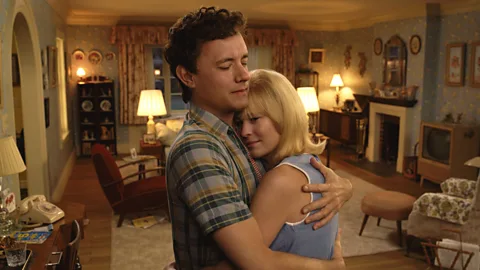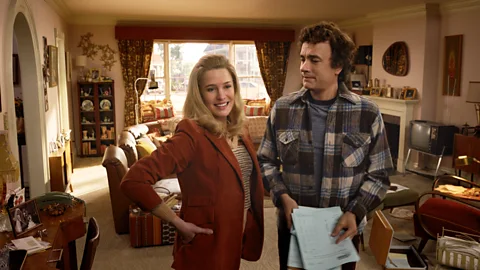 Sony Pictures
Sony PicturesThe veteran actor’s new movie Here sees him and Robin Wright looking like teenagers again. It’s the latest use of technology that could have far-reaching, and damaging, consequences.
Tom Hanks’s next film, Here, is set in the far future, the distant past, and every time period in between. Directed by Robert Zemeckis and adapted from Richard McGuire’s graphic novel of the same name, it jumps through the history of one piece of land, as seen from a single viewpoint over many thousands of years. Most of it, though, is about the decades when the area is part of an American house owned by a couple played by Hanks and Robin Wright.
For fans of Forrest Gump (1994), the most significant aspect of the trailer, which debuted last week, was the reunion of its two stars along with its director Zemeckis. But what was just as notable was the digital de-ageing that allowed Hanks and Wright to play the characters from their teens upwards. Hanks, now 67, is shown as being slim and fresh-faced, with a thick head of curly hair, just as he was when he was in Splash and Bachelor Party (1984) all those years ago. And if Zemeckis can achieve that effect in Here, how long can it be before such de-ageing is as common as using hair dye and make-up to knock a few years off an actor’s apparent age?
 Sony Pictures
Sony PicturesZemeckis has always been fascinated by how people and places change over the decades – just think of Forrest Gump itself, as well as his Back to the Future trilogy. He has also long been fascinated by digital innovation, which accounts for the creepy animated mannequins, created using real actors and motion capture technology, in The Polar Express (2004), Beowulf (2007), A Christmas Carol (2009) and the deeply weird Welcome to Marwen (2018).
As for Hanks, he seems relaxed about being able to play youthful characters until he dies – and even beyond. On The Adam Buxton Podcast last year, he said that when he and Zemeckis made The Polar Express together, they realised that there was no end to what such computerised trickery could do. “Anybody can now recreate themselves at any age by way of AI or deep-fake technology. I could be hit by a bus tomorrow and that’s it, but performances can go on and on and on and on. Outside the understanding of AI and deep-fake, there’ll be nothing to tell you that it’s not me and me alone.”
It’s unsettling to think that, in the long term, actual superstars might be replaced by their AI doppelgangers, and that, in the short term, de-ageing might allow veterans of Hanks’s generation to keep playing roles that should, by rights, be given to up-and-coming actors. But it could easily happen: de-ageing has gone from being a derided novelty to a useful film-making tool in fewer than 20 years.
In 2006, visual-effects artists de-aged Patrick Stewart and Ian McKellen pixel by pixel in X-Men: The Last Stand, and the most widespread reaction was a smirk at how shiny and robotic they looked. The technology was employed sparingly for years in such science-fiction fantasies as The Curious Case of Benjamin Button (2008) and Tron: Legacy (2010). Then, in 2019, it was a key component of several major films.
The mixed results so far
Samuel L Jackson was de-aged throughout Captain Marvel to play the Nick Fury of the 1990s; numerous actors got the same treatment in Avengers: Endgame; Will Smith was an assassin battling his younger clone in Ang Lee’s Gemini Man; and, controversially, Martin Scorsese utilised what he called “youthification” on Robert De Niro, Al Pacino, and Joe Pesci in The Irishman. But the most famous de-ageing showcase thus far was last year’s Indiana Jones and the Dial of Destiny, directed by James Mangold, which had an extended flashback to Indy tussling with the Nazis in 1944.
Some critics were excited by this high-tech reminder of how handsome Ford was in the 1980s. But many more were sceptical. When you’re used to the sight of a lined and sagging face, it can be distracting to see its uncanny, cyber-Botoxed counterpart. In The Irishman, it was laughable to hear Pesci refer to the 70-something De Niro as “the kid”. And there was no mistaking that, wrinkle-removal aside, he was broader, heavier and slower-moving than he was when he made Taxi Driver.
 Lucasfilm
LucasfilmWouldn’t it have made more sense if Scorsese and Mangold had used conventional means to rejuvenate their heroes? Seeing River Phoenix impersonate Ford when he played the school-age Indy in Indiana Jones and the Last Crusade was far more impressive than seeing Ford himself turned into a video-game character. And let’s not forget that De Niro played a younger incarnation of Marlon Brando’s Vita Corleone in The Godfather Part II, while Scott Tiler played a younger incarnation of De Niro’s Noodles Aaronson in Once Upon a Time in America – and both were triumphs. Getting back to Zemeckis, is digital retouching any more effective than the traditional methods that made the McFly family older and younger in Back to the Future?
Maybe not, but just as computer-generated settings and computer-enhanced stunts have become the norm, de-aged actors will probably soon be the norm, too. What’s striking for now, though, is how limited the uses of the technology have been. So far, de-ageing is still more of a gimmick than a serious storytelling device, and its primary purpose seems less to make characters appear younger, than to remind viewers of the films they saw when they were younger themselves.
The emotional impact of a fake young Hanks in Here relies on our memories of a real young Hanks when he was just starting out. The de-aged Ford in the last Indiana Jones film evokes the thrill of watching Indy’s classic adventures. A de-aged Mark Hamill turns up in the Star Wars TV series The Mandalorian and The Book of Boba Fett to exploit our love of the original big-screen trilogy. Meanwhile, the Abba Voyage concert residency, which opened in London in May 2022, has virtual “Abbatars” resembling the four musicians as they were in 1979.
In most cases, then, de-ageing hasn’t been used to extend superstars’ careers, or to facilitate chronology-twisting narratives – it’s been used to trigger nostalgia. Ironically for a technology that feels so futuristic and revolutionary, it’s still fixated on the past.
Here will be released in US cinemas on 15 November.


